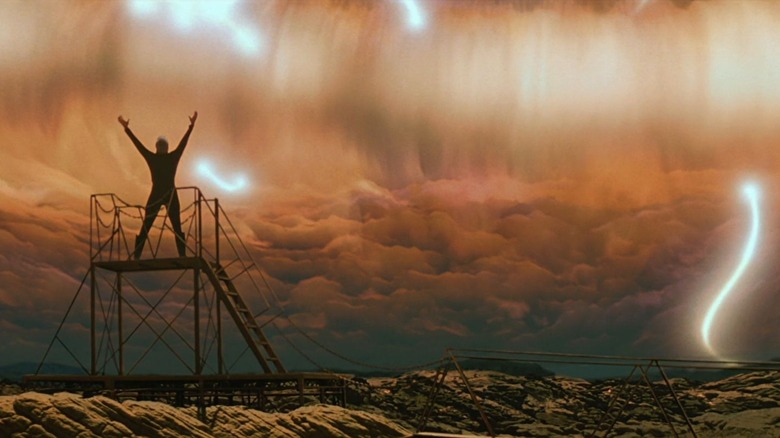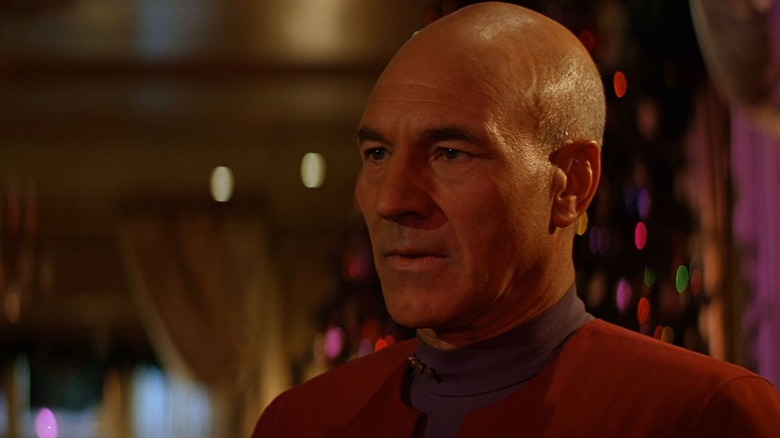One Star Trek Generations Fan Theory Will Change How You See The Rest Of The Series
In David Carson's 1994 film "Star Trek: Generations," a mad scientist named Dr. Soren (Malcolm McDowell) has been galavanting about the galaxy destroying stars and wiping out entire planetary systems. His goal is to alter the gravitational fields throughout the quadrant in order to "steer" a free-floating energy ribbon into a nearby planet. The ribbon, audiences learned earlier, was nicknamed the Nexus, as the ordinary rules of time don't apply inside of it, and all points of history happen simultaneously. The Nexus can scoop up humanoid species, and deposit them into a psychic realm of their own imagining, more or less granting their every wish. The Nexus is the "Star Trek" version of Heaven, imagined as a rogue spatial phenomenon. I guess Belinda Carlisle was wrong when she declared that Ooh, Heaven is a Place on Earth.
Soren is ultimately successful, and steers the Nexus into the planet Veridian III, where it scoops him up, along with Captain Picard (Patrick Stewart). Inside the Nexus, audiences see that Picard's version of Heaven is a warm, eternal family gathering wherein he is surrounded by well-dressed children and a wife who loves him. This stood in contrast to Picard's real life, where he just lost his brother and nephew in a fire and was feeling very alone. Although the Nexus is tantalizing, Picard eventually realizes that it's just a fantasy and that he should probably return to the real world, where he can stop Soren from blowing up all those stars.
Picard exits the Nexus, having scooped up Captain Kirk (William Shatner), and he has a fistfight with Soren, stopping his evil scheme. He also, in returning to the real world, learned to grow a little more, understanding that mourning and aging are vital, truthful parts of our lives.
But a fan theory has been floated around the Trekkie community, and can even found explored online. Namely: what if Picard never actually left the Nexus? What if he's been in there ever since "Generations?"
What if Picard is still in the Nexus?
It's worth noting that the films after "Star Trek: Generations" became a lot more violent and action-oriented. Indeed, 1996's "Star Trek: First Contact" was a straight-up action movie (without tights) that was rated PG-13. Picard got to scream in rage, shoot evil cyborgs, and face off against a villainous Borg Queen (Alice Krige). The final scene saw Picard in a tank top with a rifle slung across his back, swinging on tubes as the Borg Queen dissolved in a cloud of poison gas below him. He was a violent badass. This, of course, is entirely out of character for Picard, and the murderous tone of "First Contact" is way out of line for the ordinarily gentle TV show "Star Trek: The Next Generation" on which it's based.
This sounds a lot like an adolescent power fantasy. It's plausible to assume that "First Contact" was merely an outlet that the Nexus provided for Picard. A dark part of him wanted to take blood revenge on the Borg for all the damage they did to the galaxy and to him personally, and the Nexus allowed him to do that.
Then, in 1998's "Star Trek: Insurrection," Picard underwent a usual "Star Trek" style mission, but he also got to do some lightly sexual canoodling with an attractive woman named Anij (Donna Murphy). She tells him that she's attracted to bald men, and the film ends with Picard promising to return to her home planet on his shore leave, intending to ... well, he doesn't say "have sex," but it's implied. This was after Picard was able to defy a Starfleet admiral (Anthony Zerbe) to stand up for his principles. That there is a very Picard fantasy. He gets to be a masterful diplomat, but also a lust object. It's plausible that "Insurrection" was also a Nexus fantasy.
The Next Generation-based movies could all be a fantasy inside the Nexus
The events of "Star Trek: Nemesis" (2002) only seem to be half Nexus-inspired. The film ends with Data (Brent Spiner) sacrificing his life to save the Enterprise-E from a vicious attack, and Picard learns that he has a clone (Tom Hardy) that grew up to be a violent revolutionary. If this is a Nexus fantasy, Picard's subconscious has become very bleak. Which, of course, is possible. Perhaps the Nexus feeds you just as many negative fantasies as positive ones. The Nexus, however, most certainly provided Picard with the Argo, a dune-buggy he recklessly drove around a distant desert planet, searching for scattered android pieces. In case it needs reiteration, the Argo is perhaps one of the stupidest things in all of "Star Trek" lore.
Theories on Reddit have pointed out that "action Picard," as he appeared in movies, began the instant he left the Nexus in "Star Trek: Generations." Even in "Generations," Picard became an action star, eager to punch band guys in the face and solve problems using brute force. Perhaps Picard, despite being mannered and diplomatic and mature on the Enterprise, had finally tired of his uptight life, and longed to be a violent man with hard fists. It's also plausible to consider that Picard's ultimate dream was to stop Dr. Soren's evil scheme, and it's logical that the Nexus would have provided him with that outlet. Picard didn't really stop Soren, but he certainly dreamed that he did.
Out in the real world, Picard would have been declared dead or missing. Although, because Picard is referred to as alive throughout the events of "Star Trek: Deep Space Nine," the Nexus theory begins to fall apart a bit. I suppose the Nexus theory is merely a canonical way to explain why Picard is so out-of-character in "First Contact," "Insurrection," and "Nemesis." It couldn't, after all, just be bad writing.


